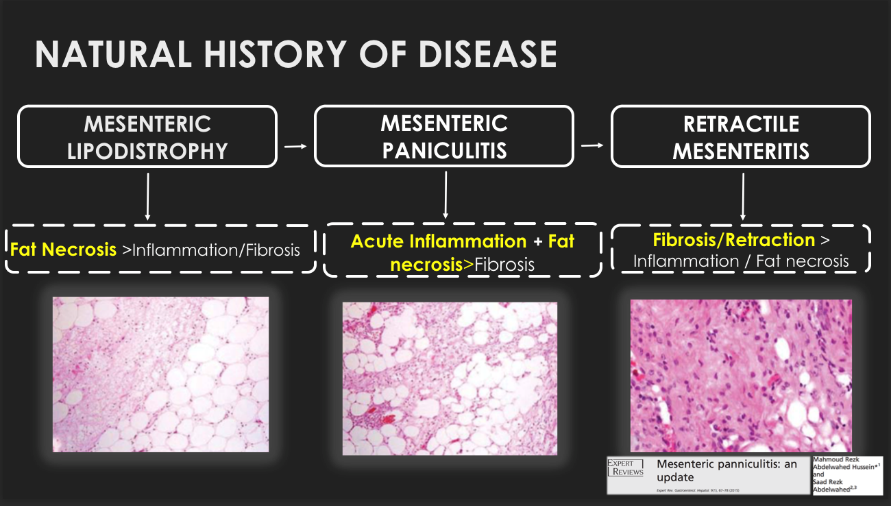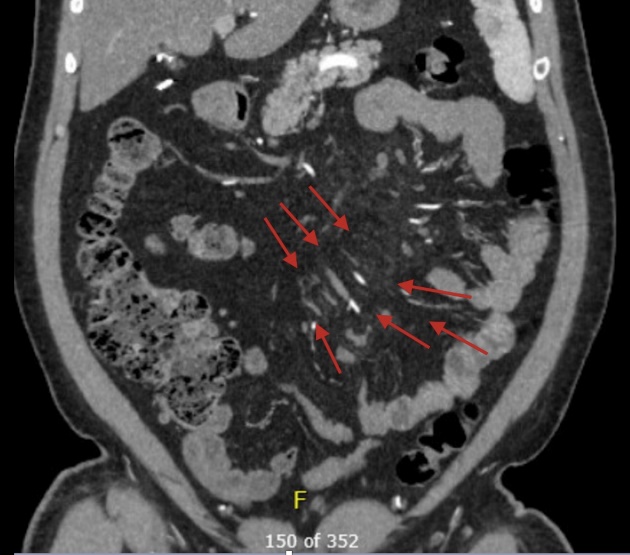Mesenteric Panniculitis
“Mesentery” is a word used to describe folds of tissue found in the abdomen, that aid in attaching the intestine to the abdominal wall to hold it in place. The prevalence of mesenteric panniculitis is not been fully defined. One study reported that findings consistent with the condition occurred in 359 patients (0.24%) from a […] Read More
Top Doctors For Mesenteric Panniculitis Treatments
Top Hospitals For Mesenteric Panniculitis Treatments
Mesenteric Panniculitis
Table of contents
“Mesentery” is a word used to describe folds of tissue found in the abdomen that aid in attaching the intestine to the abdominal wall to hold it in place. The prevalence of mesenteric panniculitis has not been fully defined. One study revealed results that were in line with the condition, which was observed in 359 of the patients (0.24 percent) of an abdominal scan of 147,794 (CT) tests carried out over five years within an extensive system of medical care for the community. Of the 100 patients, 28 percent (28 percent) were diagnosed with malignancies or were later diagnosed with cancer. The incidence of mesenteric panniculitis from recent studies has shown a range from 0.16% – 3.4%. This range depends on the method of diagnosis and whether it is histologic versus radiologically diagnosed. In some reports, the condition has a male predominance of 2:1.
What is Mesenteric Panniculitis?
Mesenteric panniculitis, also known as “sclerosing mesenteritis,” is a rare condition that affects the part of the mesentery that contains fat cells, destroying the fat cells and thereby resulting in scarring tissue within the mesentery. This is a progressive condition that is associated with an autoimmune disorder. This disorder is typically not life-threatening; it can go away on its own, but it could develop into a severe condition when left untreated.

What are the stages?
Mesenteric panniculitis comes in different stages following the progressive nature of the condition. As it progresses, more symptoms occur, and it becomes more severe. The stages include:

- Mesenteric lipodystrophy: It is the first stage of mesenteric panniculitis. Here, the fat tissues are replaced by the immune system cell.
- Mesenteric panniculitis: It is the second stage of mesenteric panniculitis. A lot of inflammation occurs during this stage due to the infiltration of immune cells into the mesentery.
- Retractile mesenteritis: It is the third stage of mesenteric panniculitis. Here, the inflammation has led to scarring, leading to scar tissue formation causing pain and other symptoms.
How is Mesenteric Panniculitis diagnosed?
Due to the rare nature of Mesenteric panniculitis, it is often misdiagnosed but can be diagnosed with:
- Computerized tomography (CT) scan is used to locate signs of thickening or scarring in the mesentery.

- A blood test is also done to see indicators of inflammation. Such blood tests as erythrocyte sedimentation rate and C-reactive protein level
- A biopsy involves taking a sample of the tissue from the inflamed mesentery. It is then sent to the lab, and its result is examined.
How is Mesenteric Panniculitis treated?
Mesenteric panniculitis does not necessarily need treatment and can heal on its own, but some steps will be taken to monitor the progress and help the patient recover. Such steps involve
- Repetition of the CT scan to monitor the level of the inflammation and its progress.
- Medications may be offered in extreme cases, aiming to suppress the overactive immune system response. Corticosteroid drugs are often used. Other medications include azathioprine, cyclophosphamide, infliximab, colchicine, thalidomide, etc.
- Surgery is only needed when people with Mesenteric panniculitis develop small intestinal obstruction.
What is the diet plan for Mesenteric Panniculitis?
For every inflammatory condition, the patient has to avoid foods that can cause more irritation. Mesenteric panniculitis is not left out. To keep the condition from worsening, follow the following dietary rules:
- Avoid red meat.
- Eat more fruits and vegetables.
- Avoid caffeine
- Quit smoking.
- Reduce alcohol intake.
What are the most common complications of Mesenteric Panniculitis?
The condition is not dangerous in itself, but complications could occur. They are listed below:
- Slowing and blockages in the intestines.
- The difficulty of the body in absorbing nutrients.
Mesenteric panniculitis is also connected to cancers, such as:
In a 2016 study, 28 percent of people with this condition either already had associated cancer or were recently diagnosed with it.
Symptoms
Symptoms may vary with individuals. It can be extremely aggressive, lasting for several months or even years, but then it goes completely.
- Abdominal pain due to pressure on organs surrounding the intestine from swelling due to inflammation.
- Nausea.
- Vomiting.
- Diarrhea.
- Constipation.
- Loss of appetite and sensation of feeling full quickly when eating.
- Weight loss.
- Stomach bloating.
- Lump in your abdomen.
- Fatigue and fever.
Causes
The exact cause of Mesenteric panniculitis has not yet been discovered, but research has shown it could be an autoimmune disease. It can also be affected by other elements, for example:
- Abdominal surgery,
- Injury to the abdomen,
- Bacterial infection,
- Vascular problems.
- Cancer such as lymphoma, colon cancer, etc.
FAQ
Panniculitis involves the inflammation of the fat in the body that would be due to several causes. Diagnosis is by clinical evaluation and biopsy.
The mesentery is an important part of the human body and essential to protect the intestines and gastrointestinal tract. Parts of the mesentery can be removed due to illness or injury but removing the entire mesentery is not possible.
The small intestine acts to absorb liquified foods through the entirety of its 22 feet (6.7 meters) like a tube. It mixes enzymes with meals and extracts nutrients that must be distributed throughout the body. Since the mesentery helps holds the intestine to the abdominal wall, the mesentery plays a vital role. Hence, without the mesentery, which holds the intestines in place, the intestines run the risk of abnormal functioning.
Most people with these inflammatory conditions recommend a diet low in pro-inflammatory foods such as red meat, fruits and vegetables, whole grains, legumes, and nuts.
Although there is no standard therapy for sclerosing mesenteritis, it can be maintained, and treatment can be carried out on how severe symptoms are in different people. Some medications are used to stabilize the condition either alone or in combination.

Picture Courtesy: Pinterest
Mesenteric panniculitis itself is not a life-threatening condition. It is caused due to inflammation of the fat cells present in the mesentery. It is considered to be a non-cancerous condition [1].
Mesenteric panniculitis is often an autoimmune disorder. Hence it is often a hereditary condition.
In most cases, it heals on its own. The symptoms can last anywhere from a couple of weeks to many years. On average, the symptoms can last about six months [2].
References
- Approach to the diagnosis and treatment of mesenteric panniculitis from the surgical point of view. Kaya C, Bozkurt E, Yazici P, İdiz U, Tanal M, Mihmanlı M. Turk J Surg. 2018;34:121–124(https://www.ncbi.nlm.nih.gov/pmc/articles/PMC6820662/#REF20)
- https://www.healthline.com/health/mesenteric-panniculitis#outlook



























































































